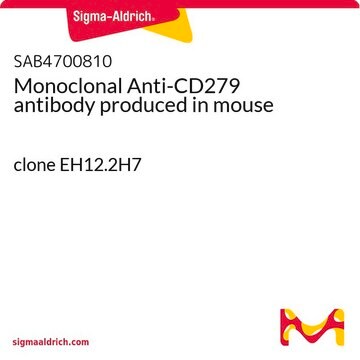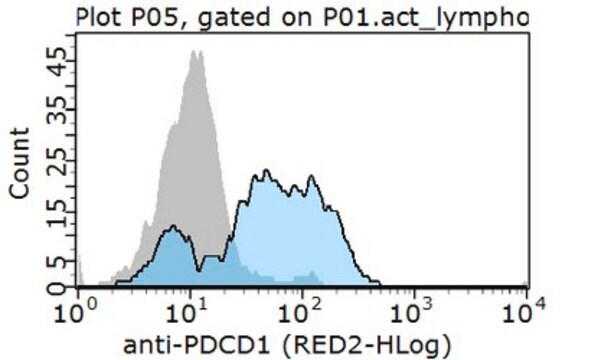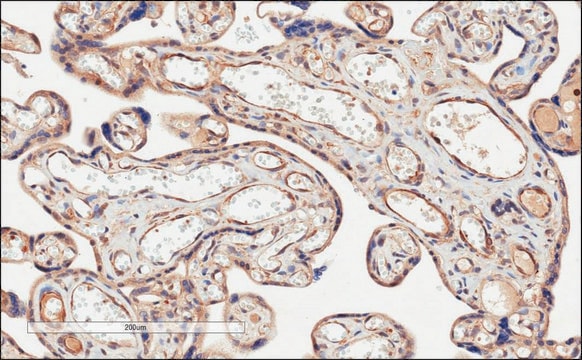MABC980
Anti-PD-L1 Antibody, clone 29E.2A3.C6, Azide Free
clone 29E.2A3.C6, from mouse
Synonym(e):
Programmed cell death 1 ligand 1, B7-H1, B7 homolog 1, CD274, PD-L1, PDCD1 ligand 1, Programmed death ligand 1
About This Item
Empfohlene Produkte
Biologische Quelle
mouse
Qualitätsniveau
Antikörperform
purified immunoglobulin
Antikörper-Produkttyp
primary antibodies
Klon
29E.2A3.C6, monoclonal
Speziesreaktivität
rat, chimpanzee, human
Methode(n)
flow cytometry: suitable
immunocytochemistry: suitable
immunohistochemistry: suitable (paraffin)
neutralization: suitable
Isotyp
IgG2bκ
NCBI-Hinterlegungsnummer
UniProt-Hinterlegungsnummer
Versandbedingung
dry ice
Posttranslationale Modifikation Target
unmodified
Angaben zum Gen
human ... CD274(29126)
Allgemeine Beschreibung
Spezifität
Immunogen
Anwendung
Apoptose & Krebs
Apoptose - Weiterführende Produkte
Flow Cytometry Analysis: 0.1 µg of this antibody from a representative lot detected PD-L1 in MDA-MB-231 cells.
Flow Cytometry Analysis: A representative lot immunostained the surface of 300.19 murine pre-B lymphoma cells transfected with human PD-L1, but not the untransfected cells or cells transfected with human PD-L2 (Brown, J.A., et al. (2003). J. Immunol. 170(3):1257-1266).
Flow Cytometry Analysis: A representative lot detected surface PD-L1 expression on human breast cancer cell lines MDA-231, SKBR-3, and MCF-7, but not BT-474 (Latchman, Y., et al. (2001). J. Nat. Immunol.2(3):261-268).
Immunohistochemistry Analysis: A representative lot detected PD-L1 expression pattern in frozen fetal (thymus & cardiac tissue) and paraffin-embedded adult (tonsillar germinal center and placenta) human tissue sections (Brown, J.A., et al. (2003). J. Immunol. 170(3):1257-1266).
Immunohistochemistry Analysis: A representative lot detected PD-L1 expression in paraffin-embedded human cancer tissue sections, including anaplastic large cell lymphoma, squamous cell carcinoma of the tongue, colon adenocarcinoma, and invasive breast ductal carcinoma (Brown, J.A., et al. (2003). J. Immunol. 170(3):1257-1266).
Neutralizing Analysis: A representative lot competed against human PD-1 extracellular domain Ig fusion for the binding of exogenously expressed human PD-L1 on the surface of 300.19 murine pre-B lymphoma cells (Brown, J.A., et al. (2003). J. Immunol. 170(3):1257-1266).
Neutralizing Analysis: A representative lot enhanced cytokines production from CD4 T-cells upon HIV Gag peptides stimulation of CD8+-depleted human PBMCs (Porichis, F., et al. (2011). Blood. 118(4):965-974).
Neutralizing Analysis: A representative lot restored HCV peptides-induced expansion of CD8+ T cells in cultured intrahepatic lymphocytes from a chimpanzee with 10 years of chronic HCV infection (Fuller, M.J., et al. (2013). Proc. Natl. Acad. Sci. U. S. A. 110(37):15001-15006).
Neutralizing Analysis: Dual blockage of both DP-L1 clone 29E.2A3.C6 Fab fragment and DP-L2 by clone 24F.10C12 (Cat. No. MABC969) Fab fragment on PBMC-derived dendric cells (DCs) boosted the enhancing effect on CD4+ T-cell proliferation and cytokine release seen with DP-L2 blockage alone in allogenic cultures with immature DCs (iDC), mature DCs (mDC), and IL-10-treated mDCs (Brown, J.A., et al. (2003). J. Immunol. 170(3):1257-1266).
Immunocytochemistry Analysis: A representative lot detected an upregulated PD-L1 immunoreactivity in human CD14+ monocyte-derived macrophages (MDMs) following HIV infection or TLR4/8 stimulation (by LPS or CL097 treatment) by fluorescent immunocytochemistry using paraformaldehyde-fixed MDMs (Rodríguez-García, M., et al. (2011). J. Leukoc. Biol. 89(4) 507–515).
Qualität
Immunohistochemistry Analysis: An 1:50 dilution of this antibody detected PD-L1 in human cerebral cortex tissue.
Zielbeschreibung
Physikalische Form
Lagerung und Haltbarkeit
Handling Recommendations: Upon receipt and prior to removing the cap, centrifuge the vial and gently mix the solution. Aliquot into microcentrifuge tubes and store at -20°C. Avoid repeated freeze/thaw cycles, which may damage IgG and affect product performance.
Sonstige Hinweise
Haftungsausschluss
Not finding the right product?
Try our Produkt-Auswahlhilfe.
Empfehlung
Lagerklassenschlüssel
12 - Non Combustible Liquids
WGK
WGK 2
Flammpunkt (°F)
Not applicable
Flammpunkt (°C)
Not applicable
Analysenzertifikate (COA)
Suchen Sie nach Analysenzertifikate (COA), indem Sie die Lot-/Chargennummer des Produkts eingeben. Lot- und Chargennummern sind auf dem Produktetikett hinter den Wörtern ‘Lot’ oder ‘Batch’ (Lot oder Charge) zu finden.
Besitzen Sie dieses Produkt bereits?
In der Dokumentenbibliothek finden Sie die Dokumentation zu den Produkten, die Sie kürzlich erworben haben.
Kunden haben sich ebenfalls angesehen
Unser Team von Wissenschaftlern verfügt über Erfahrung in allen Forschungsbereichen einschließlich Life Science, Materialwissenschaften, chemischer Synthese, Chromatographie, Analytik und vielen mehr..
Setzen Sie sich mit dem technischen Dienst in Verbindung.











